
Rothwell is a town in the south-east of the City of Leeds metropolitan borough in West Yorkshire, England. It is situated between Leeds and Wakefield.

Abbey Mills Pumping Station is a sewage pumping station in Mill Meads, East London, operated by Thames Water. The pumping station lifts sewage from the London sewerage system into the Northern Outfall Sewer and the Lee Tunnel, which both run to Beckton Sewage Treatment Works.
Southfleet is a small village and civil parish in the borough of Dartford in Kent, England. The village is located three miles southwest of Gravesend, while the parish includes within its boundaries the hamlets of Betsham and Westwood.

Cottingham is a large village and civil parish in the East Riding of Yorkshire, England. It lies 4 miles (6 km) north-west of the centre of Kingston upon Hull, and 6 miles (10 km) south-east of Beverley on the eastern edge of the Yorkshire Wolds. It has two main shopping streets, Hallgate and King Street, which cross each other near the Church of Saint Mary the Virgin, and a market square called Market Green. Cottingham had a population of 17,164 residents in 2011, making it larger by area and population than many towns. As a result, it is one of the villages claiming to be the largest village in England.
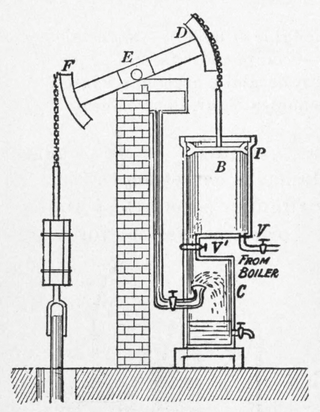
A beam engine is a type of steam engine where a pivoted overhead beam is used to apply the force from a vertical piston to a vertical connecting rod. This configuration, with the engine directly driving a pump, was first used by Thomas Newcomen around 1705 to remove water from mines in Cornwall. The efficiency of the engines was improved by engineers including James Watt, who added a separate condenser; Jonathan Hornblower and Arthur Woolf, who compounded the cylinders; and William McNaught, who devised a method of compounding an existing engine. Beam engines were first used to pump water out of mines or into canals but could be used to pump water to supplement the flow for a waterwheel powering a mill.
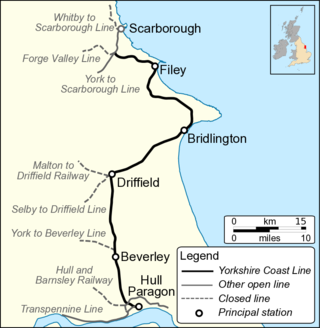
The Hull–Scarborough line, also known as the Yorkshire Coast Line, is a railway line in Yorkshire, England that is used primarily for passenger traffic. It runs northwards from Hull Paragon via Beverley and Driffield to Bridlington, joining the York–Scarborough line at a junction near Seamer before terminating at Scarborough railway station.
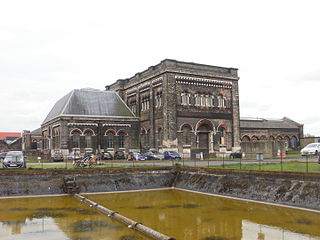
The Crossness Pumping Station is a former sewage pumping station designed by the Metropolitan Board of Works's chief engineer Sir Joseph Bazalgette and architect Charles Henry Driver. It is located at Crossness Sewage Treatment Works, at the eastern end of the Southern Outfall Sewer and the Ridgeway path in the London Borough of Bexley. Constructed between 1859 and 1865 by William Webster, as part of Bazalgette's redevelopment of the London sewerage system, it features spectacular ornamental cast ironwork, that Nikolaus Pevsner described as "a masterpiece of engineering – a Victorian cathedral of ironwork".
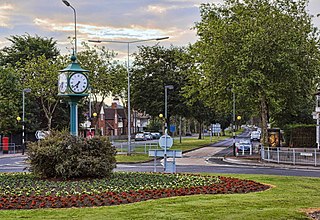
Willerby is a village and civil parish located on the western outskirts of the city of Kingston upon Hull in the East Riding of Yorkshire, England.

London Museum of Water & Steam is an independent museum founded in 1975 as the Kew Bridge Steam Museum. It was rebranded in early 2014 following a major investment project.

Springhead lies at the source of the River Ebbsfleet, just southwest of the Gravesend suburban conurbations. Springhead forms one of the major quarters of the Ebbsfleet Valley development, with housing and the associated facilities now under construction. It is the point at which the High Speed 1 rail line meets the A2 road.

Springhead is a suburban area in the civil parish of Saddleworth in the Metropolitan Borough of Oldham, in Greater Manchester, England.
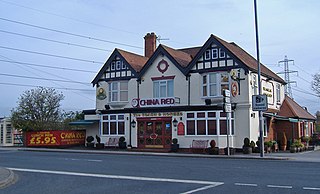
Dunswell is a village in the East Riding of Yorkshire, England, and in the civil parish of Woodmansey.
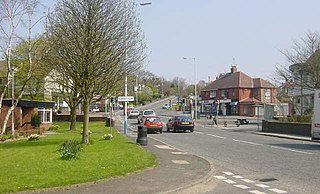
Grotton is a residential area in Saddleworth, a civil parish of the Metropolitan Borough of Oldham, in Greater Manchester, England. Located along the A669 road, it forms a continuous urban area with Austerlands and Springhead, which in turn link to Lees and Oldham, all of which are to Grotton's west.

Grotton and Springhead railway station served the villages of Grotton and Springhead from 1856 until 1955.
Southfleet was a railway station on the Gravesend West Line which served the small village of Southfleet in Kent, England.

Losh, Wilson and Bell, later Bells, Goodman, then Bells, Lightfoot and finally Bell Brothers, was a leading Northeast England manufacturing company, founded in 1809 by the partners William Losh, Thomas Wilson, and Thomas Bell.
Springhead Halt railway station was a station on the former Hull and Barnsley Railway, close to the hamlet of Wolfreton; it served the village of Anlaby in the East Riding of Yorkshire, England.

Norton House was a mansion in Midsomer Norton, Somerset. It was built around 1789 by the Savage family, investors in mines in the Somerset Coalfield. It was demolished in 1937-8 to make way for housing but several features from the house and its estate survive to this day.
Saddleworth is a civil parish in the Metropolitan Borough of Oldham, Greater Manchester, England. It lies between the town of Oldham and the Pennine hills, and it is largely rural, with agricultural land and moorland. It also includes suburban areas to the east of Oldham. The principal settlements are Austerlands, Delph, Denshaw, Diggle, Dobcross, Grasscroft, Greenfield, Grotton, Lydgate, Springhead, and Uppermill. The parish contains 385 listed buildings that are recorded in the National Heritage List for England. Of these, five are listed at Grade II*, the middle grade, and the others are at Grade II, the lowest grade.

Springhead Park is the premier park in Rothwell, West Yorkshire, England.

















